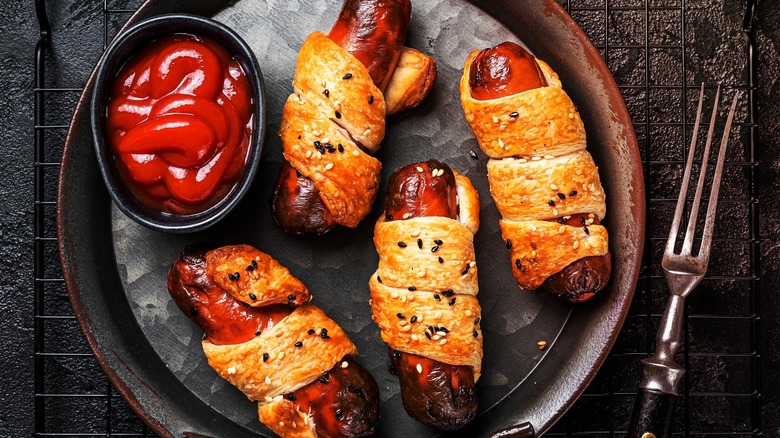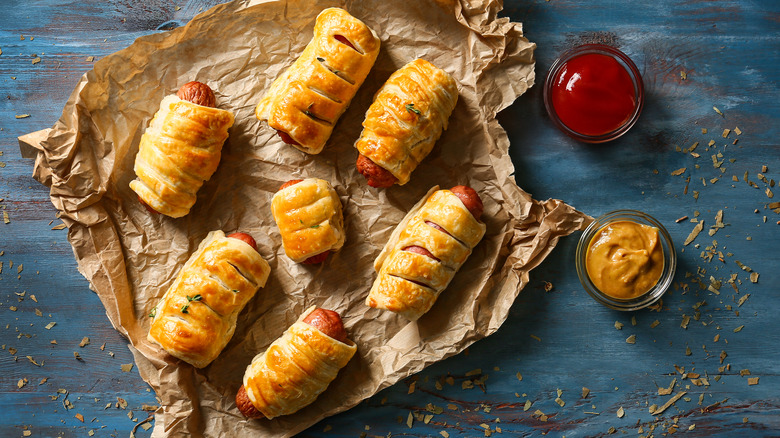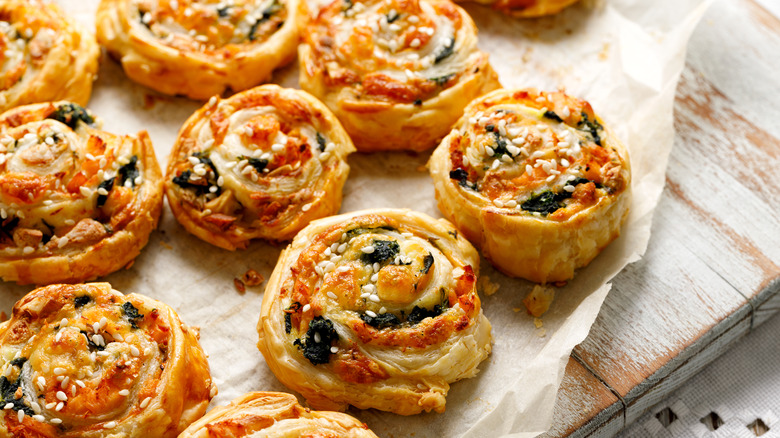Puff Pastry Scraps Are Absolutely Perfect For Pigs In A Blanket
In 1645, puff pastry — known as pâte feuilletée in French — was invented by a pastry chef's apprentice named Claudius Gele. Little did Gele know that this simple process of kneading butter through bread dough would create a culinary legacy. From sticky-sweet danishes to flaky, meaty sausage rolls, this pastry's versatility is unquestionable, and its uses are endless. Yet one puff pastry element that demands more attention is the leftover scraps. One way to remedy this? Prepare a batch of pigs in blankets.
British pigs in blankets usually see small cocktail sausages wrapped in bacon and oven-baked or grilled to crispy, meaty perfection. In contrast, pigs in blankets with puff pastry consist of juicy franks wrapped in a delectably flaky and buttery pastry. Baked until golden and crispy, these gorgeously savory bite-sized snacks are the ultimate crowd-pleaser.
You can easily cut your puff pastry scraps into long triangles or squares, place the sausage at the larger end, and roll it up. Brush with egg, and it's ready to hit the oven. If your scraps are too small to be rolled around a frank, you can layer the pastry pieces on top of one another and roll them out into longer pieces with a rolling pin. Following this tip is essential, as the layers of butter between the pastry layers must remain intact to get that fantastic flakiness and rise. Let's explore some more scrappy tips for the ultimate pigs in blankets.
A couple of pastry hacks
Even with scraps, these pigs in blankets don't need to compromise on flavor. Experiment by adding a layer of smoky, warm mustard to the raw pastry before placing the sausage on top and rolling it up. A sprinkle of chopped fresh herbs, like sweet thyme or woody rosemary, inside the pastry scraps before rolling up would also enhance the taste of this little sausage snack.
You could elevate the texture with everything bagel seasoning. A light sprinkle on top of each rolled piggy in pastry before baking not only imparts a delicious garlic tang but also enhances the visual allure and adds a satisfying crunch to the exterior of the pastry. Is garlic not your thing? Swap out the bagel seasoning for sesame seeds for some nutty undertones.
If you're storing your pastry scraps for another day, the uncooked pastry will last up to two days in the refrigerator if it's sufficiently wrapped in cling film or placed into an airtight container. Pop it in the freezer if you're unlikely to use it in time. Homemade puff pastry will last up to a month in the freezer, while store-bought will have a best-before date.
Other ideas for puff pastry scraps
Pigs in blankets are only the beginning for puff pastry scraps, as it's about to feel like the sky's the limit. The first would be to prepare simple and quick cheese straws, singing with the earthy flavors of rosemary, the creamy disposition of sharp cheddar, or a spicy hint of cayenne pepper. If you're looking for a more substantial snack, tomato and cheese pinwheels are another creative way to use scraps of puff pastry.
Who said it had to be savory? Milk chocolate swirls would puff to be gorgeously flaky and sweet with the addition of leftover pastry. They are also effortless to make, as all you need is melted chocolate, Nutella, or a chocolate-based spread that you can smother over one side of the pastry before rolling it up, baking, and serving with a sprinkle of icing sugar.
Let's look to Portugal for a little inspiration for a more substantial sweet. A pastéis de nata is a Portuguese custard tart with a fantastically sweet egg custard filling encased in a flaky, buttery puff pastry base. If the scraps are big enough, whip up some of these; they may even outshine whatever you made from the pastry in the first place.
No longer should those sad scraps of puff pastry be overlooked. Once wrapped around juicy franks, the doorway to scrap potential is opened. Roll out the welcome mat!


